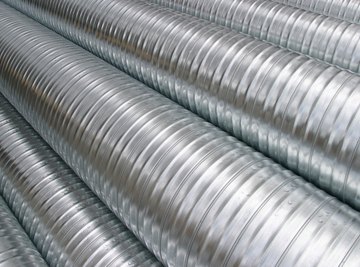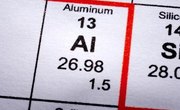
Aluminum (also spelled aluminium) is the most-abundant metal on earth and the third-most abundant element overall after oxygen and silicon. As is common with all metals, aluminum can be bent or cast into a range of shapes, giving it a wide variety of applications. Aluminum is also a good thermal and electrical conductor and has a comparatively low melting temperature.
Sources of Aluminum
Alum (aluminum potassium sulfate) was used by the ancient Romans as a dye. It was not isolated as a pure metal until 1825. Aluminum occurs naturally in the mineral bauxite, a reddish-brown ore of aluminum oxide with impurities of silicon dioxide and titanium dioxide. Bauxite deposits are found worldwide, and Australia, Guinea and Brazil are the top producers of aluminum.
Production of Aluminum
Aluminum is commercially extracted using the Bayer process, the reaction of crushed bauxite and sodium hydroxide to form sodium tetrahydroxoaluminate. The impurities in bauxite do not react with the sodium hydroxide and are therefore easily removed. Cooling sodium tetrahydroxoaluminate leads to the formation of aluminum hydroxide, which itself is then converted to aluminum oxide by heating it to about 2,000 degrees Fahrenheit. Pure aluminum is finally isolated using an electrolysis cell.
Properties of Aluminum
Unlike iron, aluminum is resistant to corrosion and oxidation. This resilience is due to the presence of a fine protective layer of aluminum oxide, which forms naturally when air comes in contact with the metal's surface. Although it is more chemically stable than iron and steel, pure aluminum is also much weaker. Aluminum is very malleable, meaning it is easy to bend, so it is an unsuitable direct replacement for steel. At just 1,220 degrees Fahrenheit, aluminum has by far the lowest melting temperature of any metal used industrially. This low melting point means it costs far less to mold and shape aluminum than steel.
Uses of Aluminum

One of the most popular uses of aluminum is kitchen foil. Aluminum is ideal for wrapping food since it is unreactive, cheap to produce and a good reflector of heat. Other household uses include kitchens and oven surfaces, drink cans, sauce pans and utensils. Aluminum is often mixed with silicon, titanium or magnesium to form strong alloys that are considerably lighter than steel. These alloys have been used to build ships, aircraft and cars. Aluminum's high electrical conductivity and corrosion resistance have made it ideal for use in outdoor and underground electrical cabling.
References
- Chemguide: Aluminium
- "Inorganic Chemistry"; D. F. Shriver et al, 1995
About the Author
Richard Beglan spent eight years as a technical writer and editor with a scientific publishing company in London. He also served as a newspaper reporter in Australia. Beglan holds a Bachelor of Science in chemistry and a foundation degree in communications, both from the University of London.
Photo Credits
Hemera Technologies/AbleStock.com/Getty Images
